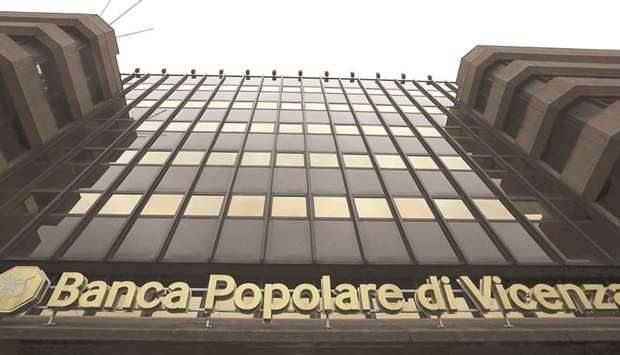The Finance Ministry said late on Friday that all measures would be taken to ensure that senior creditors and depositors of Banca Popolare di Vicenza and Veneto Banca would be protected in the wind-down under national insolvency law, and customers would see no interruption in service.
The liquidation deal may see Intesa Sanpaolo, Italy’s biggest bank by market capitalisation, take on the two banks’ good assets for a token price. In recent months the ECB, the European Commission and the Italian Treasury reviewed several options for the two lenders. In the end, they settled on a plan to split the firms into good and bad banks, with Intesa buying the good one, people familiar with the matter have said.
The government tried for months to rescue the two banks, but its efforts ended on Friday when the European Central Bank said the firms were failing or likely to fail and sent them to the Single Resolution Board in Brussels for disposal. The SRB handed the banks over to Italian authorities after concluding there was no public interest in resolving them under European Union law, a process that would have exposed senior debt to losses.
The ECB said it gave the banks “time to present capital plans,” but they were “unable to offer credible solutions going forward.”
Intesa has offered to take on the assets of the two Veneto banks on the condition that it wouldn’t harm its own capital and dividends. The bank’s proposal excluded soured debt, higher-risk performing loans and subordinated bonds, along with shareholdings and other “legal relationships.” A purchase would only move forward if it didn’t lower Intesa’s common equity Tier 1 ratio, the bank said.
The decision to allow Italy to dispose of the two banks under national insolvency law was crucial in shielding senior debt from losses. The EU’s bank-failure law, known as the Bank Recovery and Resolution Directive, puts investors, including senior creditors, on the hook for losses if necessary to fund restructuring. The BRRD is part of the EU’s attempt to prevent the public bailouts seen during the financial crisis. It remains to be seen if Italy will be allowed to use taxpayers’ cash to make the liquidation plan work. The Brussels-based commission, the EU’s executive arm, said it’s in “constructive discussions” on Italy’s proposal to provide state aid, “and good progress is being made to find a solution very soon.”
EU state-aid rules “allow for the possibility of granting state support in these kind of situations,” though shareholders and junior creditors must share losses in the process, the commission said. State-aid rules don’t require senior creditors to contribute.
Still to be determined are the losses faced by junior bondholders and equity investors in the two banks, which aren’t publicly traded. Many Italian banks have sold bonds to clients who bought them unaware of the risks involved, making it politically difficult to inflict losses on holders.



